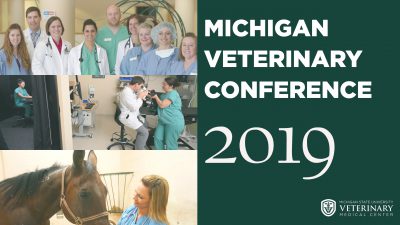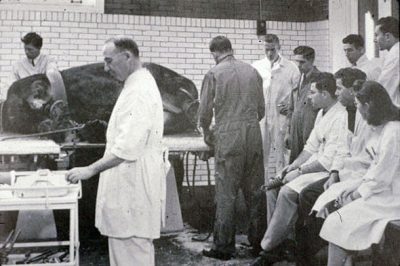
Since 1883, veterinarians have been educating students at Michigan State University, then known as the Michigan Agricultural College. It all began with Dr. Edward A. A. Grange, the first veterinarian to serve as full-time faculty. During his appointment, Grange also was the State veterinarian and president of the Michigan Veterinary Medical Association (MVMA), which was established the same year Grange began teaching at the University.
The way I see it, Grange played a unique role in Michigan’s veterinary history; I’d like to credit him for having something to do with the bonds that were formed between MSU and the MVMA. I don’t think it’s a coincidence that the same year he was appointed as the University’s first full-time faculty veterinarian, the MVMA was founded. I also don’t think it’s a coincidence how 136 years later, the two institutions—the Michigan State University College of Veterinary Medicine and the Michigan Veterinary Medical Association—still have a relationship.
A relationship that lead to events like the Michigan Veterinary Conference (MVC). MVC, which has proceedings that date back to 1989, is organized and hosted by the MVMA and the College. Since then, they have brought hundreds of veterinarians, veterinary technicians, researchers, and veterinary medical students together to learn about veterinary medicine.
But learning is only part of it. Today, the Conference offers more than 150 hours of continuing medical education (CME), which became a legal requirement for board-certified veterinarians and licensed veterinary technicians in Michigan in March 2016. Together, the College and the MVMA use the MVC to give veterinarians an opportunity to learn from leading speakers in the Industry, discover new ways to practice, engage with colleagues and content leaders to share new ideas, explore key concepts to implement in practice, and rejuvenate creativity. To many, it is known as a premier event in the veterinary industry.
The MVC isn’t only for professionals, though; it's also an opportunity for DVM and LVT students of the College to learn, as well as search for and apply to open job positions in the veterinary medical community. Practices from across the state of Michigan travel to the Conference to learn from their colleagues, advance their clinical expertise, and engage with future veterinarians and team members, which makes tangible employment opportunities to DVM and LVT students

The Michigan Veterinary Conference Today
At the 2019 Michigan Veterinary Conference, 21 faculty, graduate students, and clinicians from the MSU College of Veterinary Medicine, the MSU Veterinary Medical Center, and the MSU Veterinary Diagnostic Laboratory will be presenting. From “The Cutting Edge of Erosive Polyarthritis in the Canine and Feline” to “Surgical Tumor Pathology for the Veterinary Practitioner,” the topics cover a range of relevant areas of veterinary medicine. Not to mention, the Conference features three different wet labs, five social events, and daily yoga and guided meditations.
The relationship makes sense; The College and the MVMA both want the same things—professional excellence and the advancement of animal and human health. Together, through the MVC, the two institutions haven’t only achieved excellence; they have exceeded it by fostering an environment in which veterinary medical professionals can share and embrace knowledge, enhance their clinical skills, and practice and promote wellness. The College and the MVMA are making sure that a safe and healthy environment is the reality for the animals, people, and veterinarians of Michigan—and beyond.
From Veterinary Division to the College of Veterinary Medicine: How the College came to be—and the role Grange played in that

Medical education has been taught at Michigan State University since its establishment as the nation’s first agricultural college in 1855. The first published four-year curriculum listed “animal physiology” as a course in the third year and “veterinary” in the fourth. In 1883, the University hired its first veterinarian, Dr. Edward A. A. Grange. Grange was appointed to teach a full-year course designed to educate prospective stockmen, not to train practitioners.
In the State Board of Agriculture meeting minutes from 1883, it is noted that Grange was to give a course of lectures in veterinary science at the Michigan Agricultural College. Until 1897, Grange worked to develop veterinary science at the University and in the state of Michigan; he established a one-year veterinary course that was incorporated into the curriculum, and he committed himself to the organization of a Department of Veterinary Science.
10 years after Grange’s departure from the University, Michigan State Legislature authorized the State Board of Agriculture to form a veterinary college. In 1910, the Veterinary Division, now known as the College of Veterinary Medicine, was established as a four-year, degree-granting program. By that time, Grange had already evolved the study of veterinary science and practice of veterinary medicine in Michigan, whether he realized it or not; the partnership he fostered between MSU and the MVMA is crucial to the history of the College, the MVMA, and veterinary medicine.
